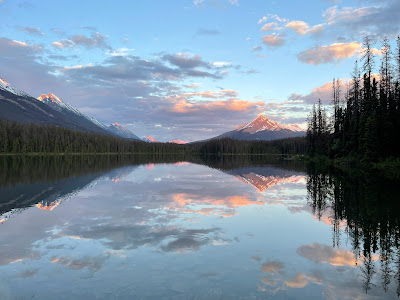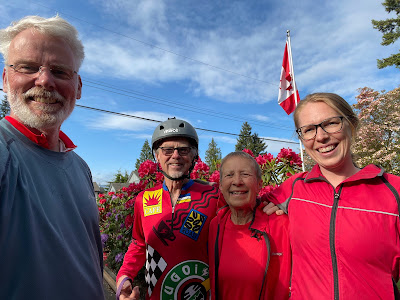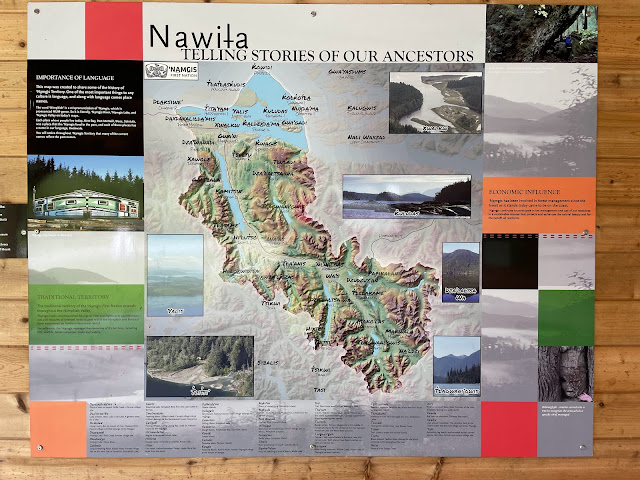Sounds like this could be a country music band. It is not, but the “country” still applies. Read on.
Day 27: Purden Lake Provincial Park to LaSalle Lake
Campground. 66 miles. +2,829’ elevation gain
Aside from being absolutely swarmed by mosquitos, it also rained most of the night whilst in my tent. In a way, this is a very soothing and comforting sound except when you really need to get up and get going (or do other business). There was a break in the patter and I made a dash for it, packing up my soaked tent and eating my breakfast while pacing the drive lane to keep the skeeters chasing. But mercifully, the clouds were suddenly breaking up, and the sun took over. (See also blog post entitled “Hot Dogs”). Overall, the ride was a roller coaster of hills with quite a bit of gain. And there was literally nothing between Prince George and McBride – a distance too far to traverse in a day. There was, just a bit north of McBride, a free, self-supported campground on LaSalle Lake. I rolled down the steep hill (thinking ahead to morning when I must climb back) to a virtually empty campground. Scanning the options, I naturally took the best spot next to the Lake.
 |
| My tent site at Lasalle - sweet, eh? |
Resting on a picnic table, not 15 minutes passed when another truck rolled in and chose another nearby spot. Then came another couple a few minutes later. Two camper vans pulled in, and I offered them my first spot as it was convenient for two vehicles side-by-side. Several other vehicles pulled in, all of this activity within half an hour of my arrival.
The woman in the first pick-up truck to roll in said hello
and asked a few questions, and was friendly while swatting mosquitos. I asked her if she would let me store my food
gear in her truck overnight to protect from bears (“yes, of course”). Over the
next hour, we chatted more and introduced ourselves and our journeys. She is a probation officer going to school to
learn about natural medicinal therapies and is on her way to Banff to compete
with a friend in a half-marathon the following Sunday. That is Brianne.
 |
| Brianne |
Little did either of us know that this particular campground was the party spot for McBride youth. Unfortunately, I was already all set up, but Brianne decided to take a more remote spot away from the expected party scene as she merely slept in her truck. I was not so lucky, and kept my spot by the lake, chatting with the occupants of the van – two couples from Switzerland. Spoke a bit of German with them.
The partyers perhaps did me a bit of a favor. As the talking and minimally diminished noise
continued all night long, it was at a time more than my earplugs could
withstand. Awake, I had a brainstorm –
if Brianne is going to Banff, she will be going right past the Lodge and
Campground in Tete Jaune Cache (pronounced tay-jjohn cashay). She could carry my panniers and drop them off
on her way. But would she?
DAY 28: LaSalle Campground to Tete Jaune Cache. 68 miles.
+2,239’ elevation gain
Morning came with two revelers still yammering at 6:00 am, and now with a bit of rain coming in. I packed up my tent and walked to Brianne’s site and had my breakfast (she had my food), and posed the question of schlepping my gear (“yes, of course”). Within about 20 minutes, my panniers were in her truck, I sent her a text message to connect with me, and then she was off to meet a friend in McBride for breakfast.
The business office of the resort
did not open until 7:30, so after she left I went ahead and called to let them know the gear
was coming, and could I make a reservation.
A person on the other end of the line was barely understandable, said
they had no vacancy, and really did not seem to understand me. Now I was worried! Had I made a mistake in not planning this
better? I double-checked the phone number
on the website and had entered it correctly.
No use - something was off. It is especially worrisome as many lodges and restaurants have closed due to COVID yet still have a web presence out there.
In this situation,
there is only one thing to do – ride on and hope for the best. As Brianne was planning to have a breakfast with a
friend in McBride, I thought if I pedaled fast enough . . . hmmm.
My bike felt naked, yet exuberantly light. I took off, and with some steep initial
climbs and a morning rainstorm, I made excellent progress over the 30 miles to
McBride, where I enjoyed a second skillet breakfast/brunch at the re-purposed
CN rail depot. No Brianne, but while there,
Jim, a local 90-year-old veteran of the CN railroad, working in this same
building for so many years, took a seat at my table and we chatted a good half
hour about the Canadian railway system. I
bought him his bagel, which he appreciated.
 |
| Jim |
Brianne should have already made it to Tete Jaune by the time I left the cafe. I kept checking my phone for messages – none yet, so I carried on at a brisk pace to a clearing sky and minor tailwind. I was flying without load, but also getting a bit worried. I finally decided to call her to see if she had any issues.
Wrong number!
I entered the number incorrectly. Now I was really worried.
She could not contact me, and I not her!
What if there was a problem at the Lodge? I put the best spin on the next 33 miles I
could, but was really just stuck with the hope that the Lodge did actually
exist, was in fact open, and if there was no vacancy, I could (hopefully) fetch my bags and move
on. Ride on!
Enter the Spooners
I was about 5 miles or so north of Tete Jaune Cache when I spotted
what appeared to be a slow-moving, pulsating mass far ahead. As I approached a bit closer, I
noted it was a group of cyclists. Now
earlier in my trip, on at least two occasions, people would ask me if I had run
across another family that was pedaling across Canada. I had not, and as they were well ahead of me, it
is only remotely possible we would cross paths anyway. But alas, here they were, grinding up a
shallow hill, and I without my panniers cruising easily up to them.
As is customary going in the same direction as another traveler, a brief chat
about where you are going is typical. In
this case, it was very simple: “so you are the family of cyclists I have heard
about . . .”
There on the roadside, we paused and
introduced ourselves. Tod and Carla,
Caleb (15), Josh (13), and Solera(11) along with Daisy, the family terrier
riding in her crate on the back of Tod’s rig – a loaded Surly Long haul Trucker. This, dear reader, is something of an amazing
scene, to see an entire family traveling.
As they had mentioned, they are often viewed as some kind of traveling
circus.
 |
| The Spooners, L to R: Solera, Carla, Joshua, Caleb, and Tod. Note the rain gear! |
I mentioned I was planning to stay at the Tete Jaune Lodge and Campground up ahead, and they are welcome to join me there. But first, Solera, the micro energizer bunny wanted to ride with me, so we rode together for a mile or so and then awaited the others. With a “see ya later – maybe” I headed off to put my mind at ease about my gear.
 |
| Solera, waiting for family to catch up after we rode together |
Tete Jaune is nothing more than a crossroad and was a fur trader's cache back in the day right in the shadow of Mount Robson, one of the more massive and impressive peaks in British Columbia. It is not hard to find the lodge, and I anxiously rode up to the office. Two ladies were chatting when I came in. There was no obvious sign of my panniers, so I introduced myself and asked if a woman had dropped off my panniers earlier in the day.
"She did. They are in the storage room.”
(THANK YOU, Brianne,
I silently yelled to myself in relief! But I still do not have her contact information
to properly thank her, but will continue the search)
They had vacancies for cute cabins with a common campground washroom. I booked two, one tiny one for me and a larger one for the
Spooners. I ran out the door just as Tod was rolling down the hill. With a yell from me, I stopped him (he was in front) as the others came by, and
told them that my gift to the Spooners was a cabin for his family, and was he
interested? We could dine together.
 |
| Breakfast in front of the cabin |
Tod is a former military police officer and a retired engineer in business for himself (and likely more accurate to call him a tinkerer and a maker), and Carla a nurse. They hail from Vancouver Island and have traveled from Victoria (milepost zero on the TransCanada Highway – just as Rich and I did) just a few days before we departed. We had a wonderful evening with a campfire (no rain), and even the next morning had breakfast before pushing off again on the road to Jasper. Again, Solera insisted on riding with me, and as it was Father’s Day, it felt right to do so! We finally parted at the Mount Terry Fox overlook. I was headed the 63 miles to Jasper, including a long climb, and needed to get going.
That is the story of Brianne and the Spooners - some country
kindness of strangers coming together.
POSTSCRIPT:
Day 30: Jasper to Honeymoon Lake Campground. 34 miles
+1,802’ elevation gain
Turns out, that was not the final goodbye.
I rode into Jasper the previous evening and took a very expensive hotel room as I had planned for a day off in Jasper. I do not care for Jasper. Too expensive, and way too touristy for my liking. The authentic towns such as McBride are more to my liking, with authentic pride. So instead, I decided I would camp up on the Icefields Parkway, at the Honeymoon Lake campground, a mere 34 miles of mostly gentle climbing. It checked all the boxes: potable water, food storage lockers (bear boxes) and a cooking shelter in case of rain, and of course a beautiful view of the lake.
 |
| Honeymoon Lake at dusk; Shackle and Clevis Peaks sunkissed |
I chose the hiker/biker site ($5 a night) and spent the late afternoon journaling, reading, dining, and napping – not necessarily in that order. It was around 7:00 or so when I heard “Peter!” from a young girl’s voice.
 |
| Our campsite with Solera consumed with my folding chair |
Yes, they too made the long trip to Jasper in one day and happened to end up in the same campground. Another evening, this time for good. It made my day!
Riding again with Solera, as she wanted it! Bikes parked at Rearguard Falls - one of our stops
You can’t follow Brianne, but you can the Spooners, also
riding for charity: the Great Cycling challenge. Check out their Instagram posts at www.instagram.com/spoonerepicadventure






































